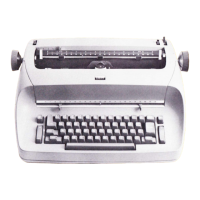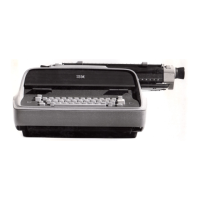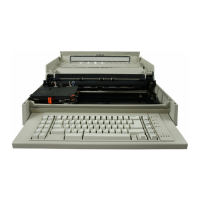FOURTH
INSPECTION
PERIOD
ESCAPEMENT
1. The
carrier
should
escape
smoothly and positively
through-
out
the
full length
of
the
writing I ine
and
through
the
right-
hand margin under
letter
escapement,
spacebar
operation,
and
tabulation.
2.
Check
for frayed
or
loose transport cords.
3.
Tension should be maintained on
the
right-hand
transport
pulley
to
maintain its mounting parallel
to
the
power
frame.
Its outside flanges should be
1-7/32"
from
the
right-hand
outside surface
of
the
power frame.
4.
The
line-gage
holder must
clear
the
platen
at
all points,
and not impede
carrier
motion.
5.
A minimum
of
.010"
clearance
should exist between
the
carrier-return
shoe and
the
spring-clutch.
Note,
however,
that
excessive
clearance
can result
in
erratic
carrier-
return motion.
6.
Check
for
1/2-3/4
pounds
of
mainspring tensiqn measured
at
the
carrier
as it escapes through the
linelock
load
at
the
extreme
right-hand
margin.
7.
Check
for
.002"
-
.004"
backlash
of
the
tab
gOVElrnor
and
carrier-return
pinion gears with
the
escapement
gear;
8.
Letter escapement should
occur
as soon
after
print as
pos-
sible.
9.
The
trigger
guide should disengage the trigger
from
the
escapement-torque-bar
arm when
the
escapement pawl
has
cleared
the
rack by
.010"
-
.015".
Both
the
letter-
escapement and
the
spacebar
operation should allow
.005"
-
.010"
excess motion
after
the
trigger
has
dis-
engaged
the
trigger
from
the
torque-bar
arm.
10. When
operated,
the
tab
lever
should overthrow
the
tab-
lever
latch
by
.005"
-
.010"
without being choked off
by
the
tab
torque-bar
lockout lug or backup
eccentric,
and
without overthrowing into
the
tab
rack.
Observe
the
operation
at
both ends and
the
middle
of
the
torque
bar.
Dynamically
check
for
tab
failures using five irregularly
set
tab
stops for
at
least five columns.
11.
Check
to make sure
that
the
carrier-return
operation
un-
latches
the
tab
when both operations
occur
simultaneous-
ly.
12. With
the
backspace
operated
manually,
the
escapement
pawl should just fail
to
get
a new tooth on
the
escape-
ment
rack.
13.
There should be a
clearance
of
.005"
-
.015"
between
the
front
of
the
backspace pawl
and
a tooth
of
the
back-
space
rack (with
the
carrier
at
rest).
14.
Overthrow
clearance
of
.010"
-
.020"
is
required
be-
tween
the
interposer pawls and
the
operational-latch
bracket
wh'en
the operational cams
are
on
their
high
point.
MOTOR
DRIVE
AND
CARRIER
RETURN
1.
Check
for
adequate
tension
of
the
motor-pulley
belt,
or
for a frayed
or
noisy
belt.
2.
The
selector
and operational cam shafts, and
the
print
and
filter
shafts, must have
.002"
end
play.
3.
There must be freedom
from
binds
in
the
idler
gear
train
with minimum
backlash.
4.
With
the
carrier-return
cam on its high
point,
the
carrier-
return arm should overthrow its
keeper
by
.020"
- . 030" .
5.
The
carrier-return
brake shoe should cause
the
carrier-
return spring
clutch
to
drive
the
carrier
no
later
than
when
the
escapement pawl
clears
the
last
one-third
of
the escapement rack
tooth.
The
clutch
shoe should
overlap
the
last three coils
of
the
spring
clutch.
6.
The
carrier-return
unlatching
link must positively
un-
latch
the
carrier-return
latch
at
the
left-hand
margin
with
.005"
-
.010"
overtravel when the margin-rack
overbank
is
set.
7.
The escapement pawl must not drag
the
escapement rack
during
carrier-return
operations.
8.
Measure
one-half
to one pound tension
of
the
shock
un-
loader
at
the
left-hand
margin while unlatching
the
carrier-return
keeper-latch
arm.
INDEXING
AND
PAPER
FEED
1.
Check
for.
015" -
.030"
clearance
between
the
platen
ratchet
and
the
index
pawl,
at
rest.
2.
Index operation should result
in
one
full-tooth
motion
of
the
index pawl with respect
to
the
platen
ratchet (in
single-linespace
position) and two
full-teeth
motion
with no
evidence
of hesitation
or
drag (in
the
double-
I inespace position).
SHIFT
Check
the
cam and spring for rust.
Turn
power
on,
and hold
the
shift
ratchet
(grey
section).
Release
the
ratchet
by press-
ing
the
magnet. Allow
the
ratchet
to
rotate
slowly while
holding down on the
magnet.
The
shift cam should stop
at
a
fully
detented
position for
each
180
0
operation.
The white
nylon
roller
should seat fully
in
cam
notch.
1-12

